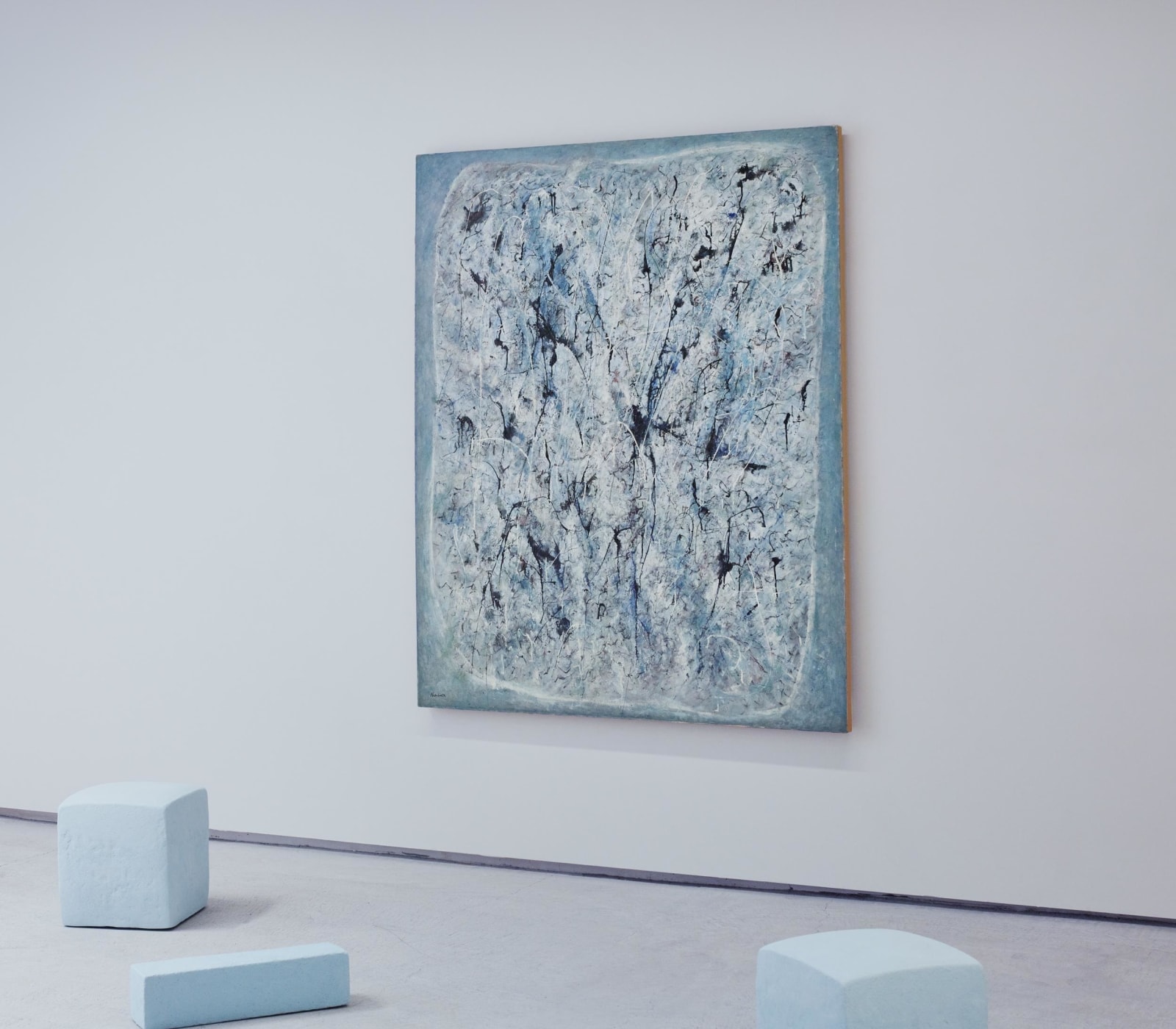Nambata Tatsuoki (1905–1997)
White Line A
Oil and enamel on canvas
Signed by the artist on the back
1962
162 x 130 cm
Signed by the artist on the back
1962
162 x 130 cm
Further images
Exhibitions
Hokushokai Hokkaido-ten, Sapporo: Sanjo Building, 1962.Tatsuoki Nambata. Tokyo: The National Museum of Modern Art, Tokyo, 1987.
Literature
Tatsuoki Nambata: Paintings, Drawings, Etchings. Tokyo: Kodansha, 1984.
Over a background of oil colors, the artist dripped black and white enamel paint to create delicate and variegated lines. It was not until 1961 that Nambata began to bring free-flowing lines to his paintings through the use of enamel. The “automatic” lines seen in the previous year’s works were composed of layers of oil-painted lines running vertically, indicating a sense of depth and space. Beginning in 1961, however, Nambata added enamel to his repertoire, interspersing vigorous black and white not just vertically but also horizontally across the entire pictorial plane. That approach was for instance used for Blue Sun and Autumn Song. These works were followed by White Line A and White Line B, both made in 1962. Here, the artist used a white line in oil to delineate a separate space inside the image, inside of which he applied the enamel. This is especially apparent in White Line A. The approach of using enamel lines was further developed in Rivalry, a later work.
Together with Akana Hiroshi, Ueno Norio, Ono Shuichi, Takahashi Yoshiaki, Hasegawa Akira, Fujisawa Yuichi and Yagi Yasuji, Nambata was a member of the Hokushokai, a group of eight abstract painters from Hokkaido that had formed in 1961. White Line A was shown at the Hokushokai Exhibition in Sapporo next year.
Where does Tatsuoki Nambata’s abstract painting come from? In “Poetry in Painting” (Shigaku, May 1980), the artist wrote, “When I was learning to paint, I devoted myself almost exclusively to sketching from nature, but I also was writing poems on the other hand. Thinking about it, I didn’t feel satisfied with paintings based on copying from nature. And when I started to make abstract paintings, I felt that even if I didn’t continue writing poems, the visual and the poetic aspects were both represented in my works as one.”
In a way, it seemed just a natural course of things that Nambata, who was active in poetry even before the war, would find his place in abstract painting.
Nambata Tatsuoki (yoga painter; 1905–1997)
Painter from Hokkaido. Nambata studied at Waseda University but dropped out, enrolling instead at the Taiheiyo art school. Via introduction by Takamura Kotaro, he was accepted into the Kin’yokai art association led by Kawashima Riichiro. His work Kodachi was shown at the Fourth Kokuga exhibition. After leaving the Kokuga Sosaku Kyokai, Nambata co-founded Avant-garde Artists Association and Free Artists Association. He continued to work in abstract painting after the war, and received a major retrospective at the National Museum of Modern Art, Tokyo, in 1987. Nambata received the Mainichi Art Award; he also published the books Chusho (Abstraction) and So (Blue).
Together with Akana Hiroshi, Ueno Norio, Ono Shuichi, Takahashi Yoshiaki, Hasegawa Akira, Fujisawa Yuichi and Yagi Yasuji, Nambata was a member of the Hokushokai, a group of eight abstract painters from Hokkaido that had formed in 1961. White Line A was shown at the Hokushokai Exhibition in Sapporo next year.
Where does Tatsuoki Nambata’s abstract painting come from? In “Poetry in Painting” (Shigaku, May 1980), the artist wrote, “When I was learning to paint, I devoted myself almost exclusively to sketching from nature, but I also was writing poems on the other hand. Thinking about it, I didn’t feel satisfied with paintings based on copying from nature. And when I started to make abstract paintings, I felt that even if I didn’t continue writing poems, the visual and the poetic aspects were both represented in my works as one.”
In a way, it seemed just a natural course of things that Nambata, who was active in poetry even before the war, would find his place in abstract painting.
Nambata Tatsuoki (yoga painter; 1905–1997)
Painter from Hokkaido. Nambata studied at Waseda University but dropped out, enrolling instead at the Taiheiyo art school. Via introduction by Takamura Kotaro, he was accepted into the Kin’yokai art association led by Kawashima Riichiro. His work Kodachi was shown at the Fourth Kokuga exhibition. After leaving the Kokuga Sosaku Kyokai, Nambata co-founded Avant-garde Artists Association and Free Artists Association. He continued to work in abstract painting after the war, and received a major retrospective at the National Museum of Modern Art, Tokyo, in 1987. Nambata received the Mainichi Art Award; he also published the books Chusho (Abstraction) and So (Blue).





